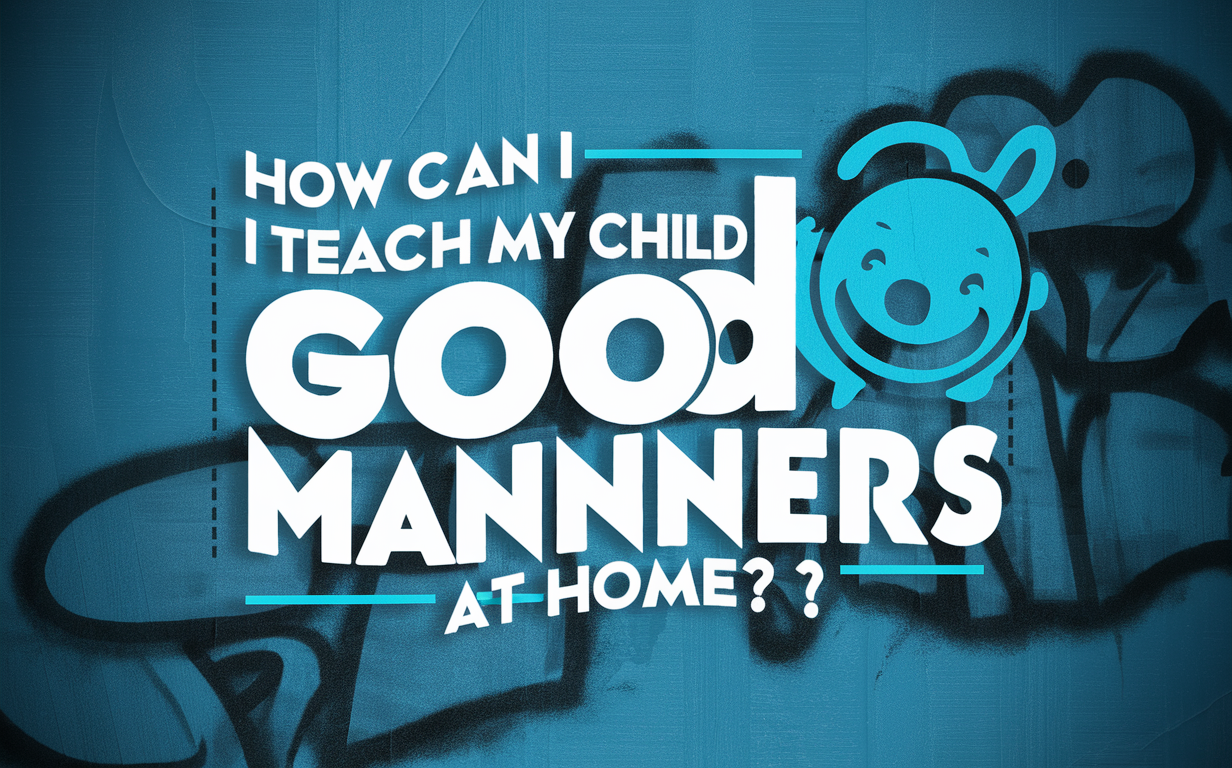Cultivating Kindness, Respect, and Confidence in Your Child
In a world that often feels rushed and impersonal, teaching children good manners is more important than ever. It’s not about memorizing a stuffy list of outdated rules. It’s about instilling a profound sense of empathy, respect, and social awareness that will serve them for a lifetime. Good manners are the building blocks of positive relationships, the key to navigating social situations with confidence, and a reflection of a kind and considerate heart.
This comprehensive guide will walk you through the why, what, and how of teaching manners at home. We’ll provide practical, age-appropriate strategies and fun activities to transform this essential life lesson from a chore into a joyful part of your family’s culture.
Core Foundations for Success
Before diving into specific rules, it’s vital to establish a strong foundation. These four principles are the soil in which good manners grow.
1. Lead by Example (More is Caught Than Taught)
Children are exceptional observers. Your daily actions speak far louder than any lecture. Do you say “please” to your partner? Do you thank the cashier at the grocery store? Do you hold the door for the person behind you? Your consistent modeling of polite behavior is the single most powerful tool you have.
2. Start Early and Be Patient
Mannerscan begin as soon as your child starts to communicate. A toddler can learn to wave “bye-bye” or make a sound for “thank you.” The key is age-appropriateness and immense patience. Mistakes will happen. There will be forgotten “pleases” and loud interruptions. See these not as failures, but as teachable moments.
3. Be Consistent
Consistency is crucial for learning. The rules for manners should apply everywhere—at home, at the park, at grandma’s house. If using a napkin is expected at dinner, it should be expected every dinner. This predictability helps children internalize the behavior until it becomes second nature.
4. Use Positive Reinforcement
Focus on catching your child being good. When you notice them using their manners without being prompted, offer specific and heartfelt praise. “I really loved how you said ‘excuse me’ when you needed to get by. That was so thoughtful!” This positive attention is far more effective than constant correction and nagging.
Think of manners as ‘social lubrication.’ They aren’t about being fancy; they’re about making interactions with others smoother, kinder, and more respectful for everyone involved.
The Five Magic Words
These five simple words and phrases form the bedrock of polite interaction. Make them a non-negotiable part of your family’s vocabulary.
Please
Turns a demand into a polite request. It shows respect for the other person’s time and effort.
Thank You
Acknowledges a kindness, a gift, or a service. It’s a simple expression of gratitude that makes others feel appreciated.
You’re Welcome
The gracious response to “thank you.” It closes the loop of gratitude and shows that the act of giving was a pleasure.
Excuse Me
Used to get someone’s attention politely, to move past someone, or after an accidental burp or sneeze.
I’m Sorry
A powerful phrase for taking responsibility for a mistake or for hurting someone’s feelings. It’s a cornerstone of empathy.
An Age-by-Age Guide to Manners
Manners are not one-size-fits-all. What you expect from a pre-teen is very different from what a toddler can manage. Here’s a breakdown of what to focus on at each stage.
Focus: Basic Social Scripts & Physical Actions
At this age, it’s all about repetition and simple connections between actions and words. They are learning to mimic you.
- The Magic Words: Start introducing “please” and “thank you.” You can even use sign language for these before they can speak clearly.
- Greetings: Encourage waving “hello” and “goodbye” to people.
- No Hitting/Biting: The most basic manner of all—respecting others’ bodies. Teach “gentle hands.”
- Sharing (The Concept): While true sharing is a complex skill, you can introduce the idea of taking turns with toys.
- Cleaning Up: Start the habit of helping put away one or two toys before moving to the next activity.
Focus: Growing Awareness of Others
Preschoolers can begin to understand that other people have feelings. Empathy starts to blossom.
- Mastering Magic Words: Consistently using “please,” “thank you,” and adding “excuse me” for interruptions or sneezes.
- Covering Mouths: Teach them to cough or sneeze into their elbow (“the vampire cough”).
- Not Interrupting: A tough one! Teach them to gently put a hand on your arm and wait if you are speaking to another adult.
- Asking to Play: Instead of grabbing toys, encourage them to ask friends, “Can I play with that when you’re done?”
- Basic Table Manners: Staying seated for a short period, using utensils (even messily), and not throwing food.
Focus: Developing Social Graces & Responsibility
School-age children can handle more complex social rules and understand the “why” behind them.
- Being a Good Host/Guest: Welcoming friends to their home, offering them a drink or snack. Saying thank you for having them over when they are a guest.
- Polite Conversation: Making eye contact when speaking, not talking with their mouth full, and learning to ask others questions about themselves.
- Respecting Privacy: Knocking on closed doors before entering.
- Thank-You Notes: For birthday and holiday gifts, a simple, handwritten note teaches immense gratitude.
- Phone Etiquette: How to answer the phone politely (“Hello, this is [Name].”) and take a message.
Focus: Nuanced Social Skills & Digital Citizenship
Pre-teens are navigating more complex social hierarchies and the digital world. Manners become about thoughtfulness and integrity.
- Acknowledging Adults: Looking up from their screens and saying hello when an adult enters the room.
- Offering Help: Proactively offering to help clear the table, carry groceries, or assist a younger sibling without being asked.
- Digital Etiquette (Netiquette): No name-calling online, thinking before they post, understanding that digital words have real-world impact.
- Sportsmanship: Winning and losing gracefully. Congratulating the other team regardless of the outcome.
- Respectful Disagreement: Learning that it’s okay to have a different opinion, but it’s not okay to be rude or dismissive about it.
The Table Manners Masterclass
The dinner table is one of the best classrooms for manners. It’s a daily opportunity to practice respect, patience, and consideration. Here’s a step-by-step guide.
Step 1: Come to the Table Ready
This means hands are washed, faces are clean, and any toys or devices have been put away. The table is for eating and connecting.
Step 2: Wait Patiently
Teach children to wait until everyone is served (or at least the adult who is serving) before they begin eating. This shows respect for the cook and fellow diners.
Step 3: Use Your Napkin
As soon as you sit down, the napkin goes on the lap. Use it to dab your mouth, not as a bib or a tissue for your nose.
Step 4: Chew with Your Mouth Closed
A classic for a reason. No one wants to see or hear food being chewed. Also, teach them not to talk with a full mouth.
Step 5: Ask for Things to be Passed
Instead of reaching across the table (and someone’s plate), teach the polite phrase, “Please pass the potatoes.”
Step 6: Participate in Conversation
Encourage them to share about their day and to ask others about theirs. The dinner table is a place for family conversation, not silence.
Step 7: Ask to Be Excused
When finished, they should ask, “May I please be excused?” before leaving the table, rather than just bolting.
Step 8: Clear Your Plate
A wonderful habit of responsibility. Teach children to take their own plate, cup, and cutlery to the kitchen sink area.
Making Manners Fun: Games & Activities
Turning lessons into games is a fantastic way to engage children and make the concepts stick. Try these fun activities with your family.
The Royalty Dinner
Announce that tonight, you’re dining with royalty! Everyone must use their absolute best table manners. Use fancy (or just different) dishes. Address each other as “Your Majesty” or “Your Highness.” This playful exaggeration makes practicing manners a fun performance.
The Polite Interruption Game
Practice the “interruption rule.” Two adults have a conversation. The child’s job is to approach, place a hand on an arm, and wait quietly. The moment the adults pause, they say “Great job waiting patiently! What did you need?” This role-play takes the stress out of a real-life situation.
Manners Charades
Write different polite (and impolite) actions on slips of paper (“chewing with mouth open,” “saying thank you,” “holding a door,” “interrupting”). Take turns acting them out and have the family guess the manner. It’s a hilarious way to highlight the difference.
Thank-You Note Art Party
Turn the “chore” of writing thank-you notes into a creative session. Get out stickers, markers, and colorful paper. Let the child decorate the card while you help them write a simple sentence of thanks. This associates gratitude with fun and creativity.
Handling Common Challenges (FAQ)
Teaching manners isn’t always a smooth ride. Here are some common hurdles and how to navigate them with grace.
Conclusion: The Lifelong Gift of Grace
Teaching your child good manners is one of the most profound and lasting gifts you can give them. It’s a journey, not a destination, filled with teachable moments, lots of practice, and incredible rewards. You’re not just teaching them to be polite; you’re teaching them to be aware, to be kind, to be respectful, and to be the type of person others want to be around.
By leading with love, patience, and consistency, you are equipping your child with the social and emotional intelligence to build strong relationships, navigate the world with confidence, and leave every situation a little better than they found it. That is the true, beautiful magic of manners.
Disclaimer: This content was automatically imported from a third-party source via RSS feed. The original source is: https://babieblue.com/how-can-i-teach-my-child-good-manners-at-home/. xn--babytilbehr-pgb.com does not claim ownership of this content. All rights remain with the original publisher.


Modern Social & Digital Etiquette
Manners extend far beyond the dinner table. Here’s how to guide your child through common social situations in the 21st century.
Greetings and Introductions
Teach your child to look people in the eye, offer a firm handshake (if appropriate for your culture), and say, “It’s nice to meet you.” When you are with your child and meet someone you know, make the introduction: “Mary, this is my son, Leo. Leo, this is my friend, Mary.” This makes the child feel included and important.
Public Places
Remind them to use their “inside voice” in places like libraries, restaurants, and places of worship. Teach them to hold doors for people behind them and to be mindful of personal space in lines, not crowding the person in front.
Digital Etiquette (“Netiquette”)
This is a critical area for modern parenting. The core principle is simple: The Golden Rule applies online. If you wouldn’t say it to someone’s face, don’t type it.